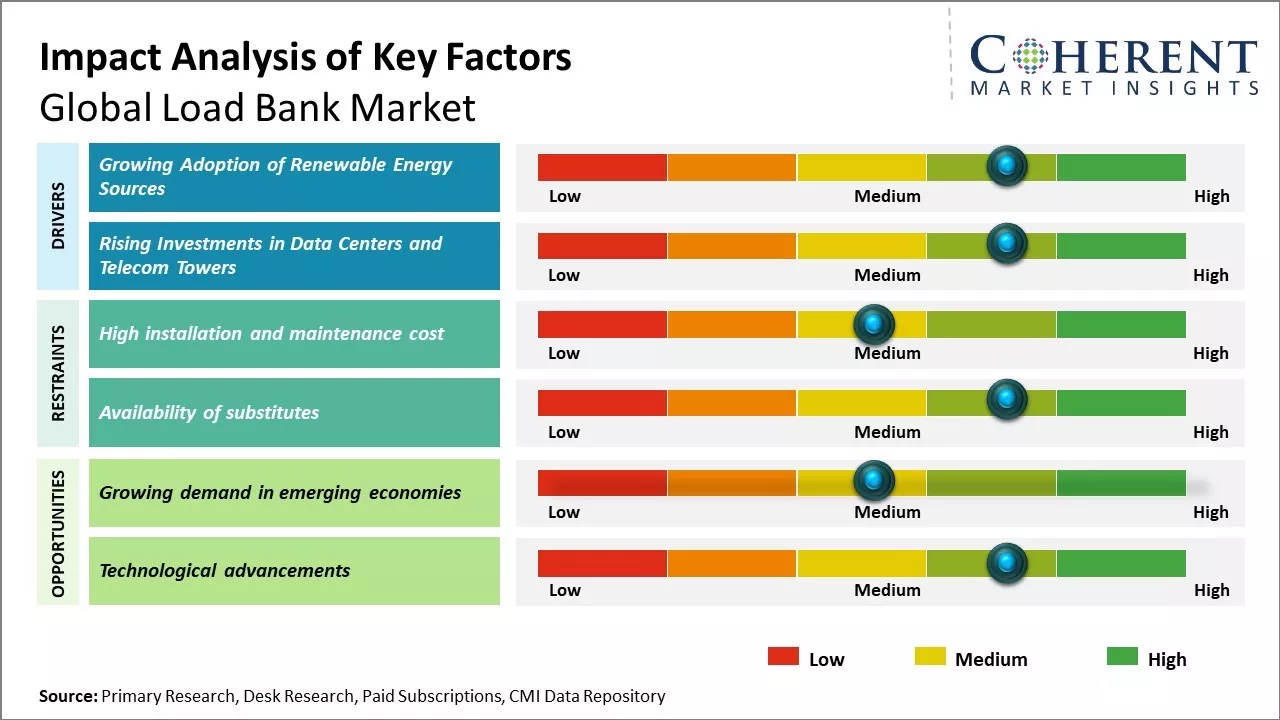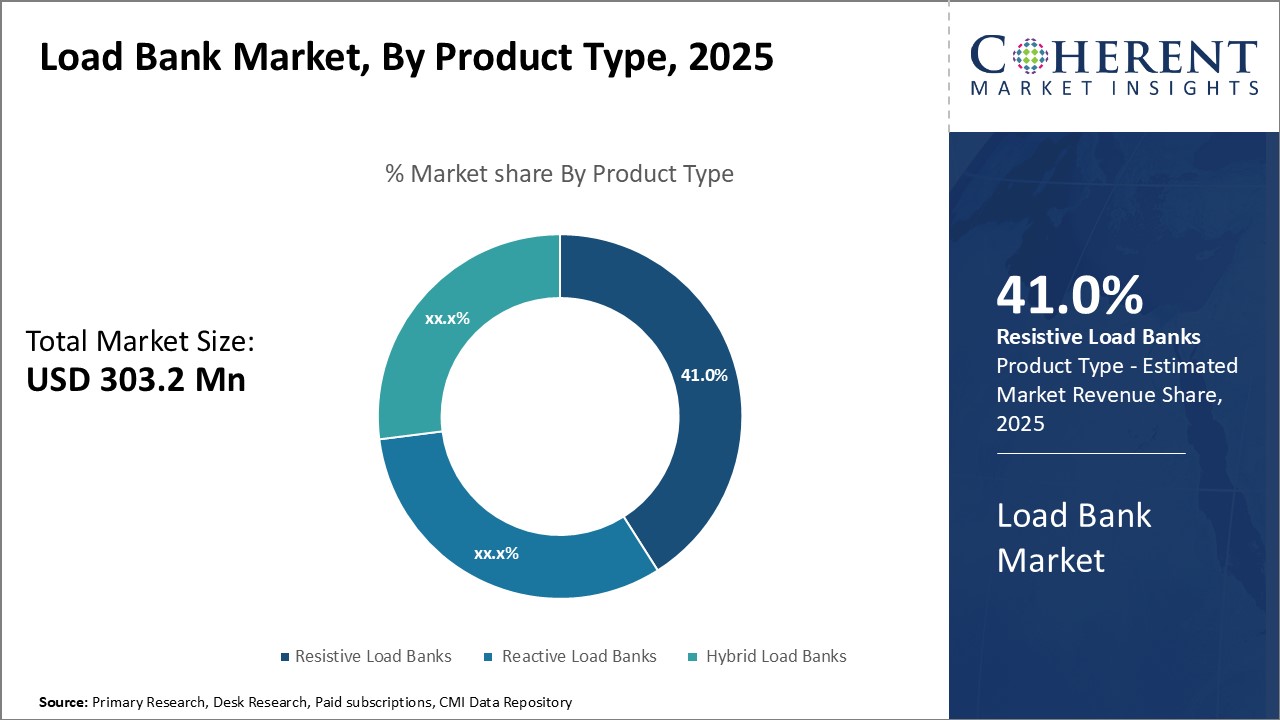Load Bank Market Size and Trends
The load bank market is estimated to be valued at USD 303.2 Mn in 2025 and is expected to reach USD 412.9 Mn by 2032, exhibiting a compound annual growth rate (CAGR) of 4.5% from 2025 to 2032.

Discover market dynamics shaping the industry: Download Free Sample
Load Banks are essential equipment for testing backup power sources such as generators and UPS systems. They are used to simulate electrical loads and draw current to test the performance of generators under various load conditions without connecting the actual equipment that will use power from the generator. The load bank market is expected to witness steady growth over the forecast period. Wide applications of load banks for testing generators across various end-use industries, such as data centers, telecommunication, manufacturing, and automotive, are expected to drive market growth. Additionally, the increasing need for reliability and efficiency of backup power solutions is resulting in more frequent testing and maintenance of generators and UPS systems using Load Banks. However, the availability of alternative test methods and economic slowdowns hampering capital investments can restrain the growth of the load bank market during the forecast period.
Growing Adoption of Renewable Energy Sources
The increasing focus on cleaner and greener sources of energy is positively impacting the load bank market. Replacing conventional power generation with renewable power requires efficient energy storage, transmission, and distribution infrastructure to optimize power output and meet demands. Load banks play a vital supporting role by enabling testing and commissioning of renewable energy assets such as solar parks, wind farms, and energy storage facilities before connecting them to the main power grid. They help simulate full or partial load conditions to identify design flaws and ensure reliable performance under all scenarios. With renewable penetration targets rising significantly across many countries over the next decade to curb greenhouse gas emissions, the deployment of utility-scale renewable projects is expected to surge. This will augment the demand for load banks from project developers and component manufacturers to certify quality before deployment.
Market Concentration and Competitive Landscape

Get actionable strategies to beat competition: Download Free Sample
Rising Investments in Data Centers and Telecom Towers
The explosive growth of digital services and connectivity needs is increasing the worldwide appetite for ubiquitous data storage and processing infrastructure. Billions are being invested by both private and public organizations to establish large data centers and build next-generation telecommunication networks. However, setting up such complex infrastructure presents numerous electrical system challenges due to their scale, complexity and stringent reliability needs. Load banks serve as an invaluable tool in the commissioning and maintenance of these facilities. They enable simulation of full system load conditions before connecting to the main power source to identify bottlenecks. Regular load bank testing also ensures backup power systems and redundant electrical configuration is robust enough in the event of planned or unplanned outages. With data center capacity continuing to multiply at a rapid pace globally and 5G rollouts underway, the demand for load banks from these sectors is expected to rise considerably to address their stringent quality control needs.
Key Takeaways from Analyst:
The demand for load banks is being driven by factors such as rising investments in data centers and rapid industrialization across developing regions. Additionally, the need for emergency and backup power solutions from various industries will spur opportunities for load bank providers. However, strict environmental regulations regarding product emissions pose a challenge to market players.
North America currently dominates the global load bank market, aided by robust investments to upgrade critical infrastructure in the U.S. and Canada. The regional market is further boosted by frequent power outages caused due to extreme weather conditions. Meanwhile, Asia Pacific exhibits high growth potential and can emerge as the fastest growing regional market. This can be attributed to ongoing industrial and economic development across major countries like China and India.
Load bank manufacturers must focus on developing innovative products that comply with tightening environmental norms. Entering into partnerships with industrial power consumers can help gain new clients and strengthen market position. Adopting green manufacturing practices and utilizing renewable energy for operations will allow vendors to minimize carbon footprint. Investing in R&D to introduce load banks suitable for various applications like data centers, telecom industry, and oil and gas sector will open new revenue streams.
Market Challenges: High installation and maintenance cost
High installation and maintenance cost is one of the major factors restraining the growth of the global load bank market. Load banks require high initial investment for purchasing and installing the equipment. The cost of load banks varies significantly depending on various factors such as type, ratings, enclosure type etc. Advanced digital load banks with automatic control systems tend to be more expensive than conventional resistive or reactive load banks. Additionally, load banks need to be installed by trained technicians considering all the safety measures which further adds to the overall cost. Regular maintenance and servicing of load banks is also important to ensure optimal performance throughout their lifespan. This involves additional operational expenditure. The maintenance cost depends on various operating hours and environmental conditions where the load bank is installed. Unplanned downtimes due to equipment failure also contribute to the overall maintenance cost.
Market Opportunities: Growing demand in emerging economies
The integration of smart grid and smart city initiatives presents a major opportunity for growth in the global load bank market. As more cities look to modernize their infrastructure to become more sustainable and efficient, the demand for load banks will increase significantly. Load banks play a crucial role in testing backup power sources like generators and UPS systems that are integral to smart grids and ensuring reliable power for critical infrastructure in smart cities. With smart cities aiming to increase reliance on renewable energy sources like solar and wind, load banks allow regular testing and maintenance of energy storage solutions that help balance intermittent power sources. They also help test emergency power supplies for public services, transportation, communication networks and other essential systems in smart city projects.

Discover high revenue pocket segments and roadmap to it: Download Free Sample
Insights by Product Type: Resistive Load Banks Dominate Due to Simplicity and Cost-effectiveness
Resistive load banks is expected to contribute 41.0% share of the load bank market in 2025, due to their simplicity and cost-effectiveness. Resistive load banks function through dissipating power using heat produced through resistors. This basic operating principle allows resistive load banks to be less complex and cheaper to manufacture than reactive or hybrid load banks. The simplicity of resistive load banks translates to high reliability and durability. With few moving parts and no reactive components, resistive load banks are less prone to failures that can plague more complex load bank types. This reliability reduces maintenance costs and downtime for users. The minimal electronics required also make resistive load banks durable enough to withstand rugged industrial environments.
In addition, the low component costs of resistors mean resistive load banks have significantly lower price tags than other options. The lack of extra components removes substantial expenses from the manufacturing process. This affordability expands the potential customer base of resistive load banks to include more budget-conscious buyers. Organizations that only require occasional or temporary load bank use are especially attracted to the upfront cost savings. While reactive and hybrid load banks can simulate more intricate load profiles, most basic applications do not require this complexity. For users primarily concerned with testing generator performance under loaded conditions, the simplicity and value proposition of resistive load banks remains very appealing. As a result, resistive load banks will likely continue dominating the largest segment of the load bank market.
Insights by Application: Power Generation is the Primary Driver of the Load Bank Market Growth
The power generation segment is expected to contribute 30.8% of the market share in 2025 due to unique testing needs of the industry. Power generators must undergo regular load bank testing to certify performance and reliability. This testing exposes generators to controlled load conditions that simulate real-world use. It allows the identification of any issues before deployment and ensures generators can reliably deliver rated power outputs. Compliance with industry standards and regulations drives much of the load bank testing conducted by power generators. Infrastructure must adhere to strict guidelines regarding power quality and safety. Load bank tests provide necessary data to satisfy regulatory bodies. Additionally, as energy infrastructure ages, utilities rely heavily on load bank testing for predictive maintenance. It helps determine refurbishment priorities and avoids unexpected breakdowns.
Both conventional fossil fuel power plants and renewable energy sites utilize load banks for testing needs. However, growth in renewable integration is elevating the importance of energy storage solutions like batteries. These stored energy technologies require intensive load cycling to evaluate performance over long usage cycles. Their increasingly critical role in stabilizing intermittent renewable resources corresponds to rising load bank demand. Overall, the power generation segment will remain the key driver of load bank market expansion due to performance testing requirements. Strict compliance and predictive maintenance needs ensure consistent load bank procurement. Emerging energy storage solutions tied to renewables integration present new opportunities for load bank suppliers going forward.
Regional Insights

Need a Different Region or Segment? Download Free Sample
North America has established itself as the dominant region in the global load bank market with 30.3% of the market share in 2025. The presence of major load bank manufacturers such as Simplex, Metal Deployed, and Coudoint S.A. has led to the widespread availability and adoption across various end-use industries over the years. Majority of power projects in the oil & gas, mining, and data center construction sectors in the U.S. and Canada utilize load banks to test backup power systems, making North America the largest consumer base globally. Ease of access to technologically-advanced product offerings and robust infrastructure further aids the growth of the load bank market.
The Asia Pacific region has emerged as the fastest growing market for load banks in recent times, primarily driven by China and India. Rapid industrialization and infrastructure development activities relating to renewable energy, construction, and technology sectors in the expanding economies have ramped up demand. Major companies from North America and Europe are also establishing local manufacturing plants to directly serve the developing APAC markets and reduce delivery times. This ensures reliable supply and competitive pricing to clients.
Market Report Scope
Load Bank Market Report Coverage
| Report Coverage | Details | ||
|---|---|---|---|
| Base Year: | 2024 | Market Size in 2025: | USD 303.2 Mn |
| Historical Data for: | 2020 To 2024 | Forecast Period: | 2025 To 2032 |
| Forecast Period 2025 to 2032 CAGR: | 4.5% | 2032 Value Projection: | USD 412.9 Mn |
| Geographies covered: |
|
||
| Segments covered: |
|
||
| Companies covered: |
Asco Power Technologies, Schneider Electric, Avtron Power Solution, Mosebach Manufacturing Company, Simplex, Inc., Crestchic Limited, Testek Solutions, Sephco Smartload Banks, Hebei Kaixiang, Tatsumi Ryoki, Metal Deploye Resistor, KWK-Resistors, Perennial Technologies, Aktif Group, Ohmark Controls Private Limited, Om industries, Trutech Products, Mahesh Electrical Instruments, KVA Applications, Kiyosh Electronics |
||
| Growth Drivers: |
|
||
| Restraints & Challenges: |
|
||
Uncover macros and micros vetted on 75+ parameters: Get instant access to report
Load Bank Industry News
- In 2023, Crestchic, a leading manufacturer of load banks and testing equipment, announced that it has provided formal load bank training to one of the most elite naval forces globally. The training was conducted following the arrival of Crestchic's 3000 kVA, 3-phase load bank with NOVA control hardware and Orion user interface.
- In 2022, Eagle Eye Power Solutions, a leading provider of power system solutions and services, announced the expansion and relocation of its headquarters to Mequon, Wisconsin. The new headquarters features an onsite battery learning lab as part of Eagle Eye University, providing hands-on training and education for customers and partners.
- In 2022, Cummins Inc., a global power leader, announced the launch of its new 1MW twin-pack rental generator, C1000D6RE. This new product offers a competitive rental power solution for various applications throughout North America, ensuring greater reliability for rugged portable power applications and others.
- In 2022, Resistor manufacturer launches new load bank division
*Definition: A load bank is a test equipment used to simulate the load of an electric power system and used mainly for testing the performance, durability and reliability of standby power sources like generators, uninterruptible power supplies and other electrical power equipment. Load banks allow the testing of generator sets and UPS systems at a controlled amount of load without actually connecting the equipment to facility power distribution systems or critical loads. A load bank dissipates the electrical output of the power source being tested as heat energy instead of powering actual equipment.
Market Segmentation
- Product Type Insights (Revenue, USD Mn, 2020 - 2032)
- Resistive Load Banks
- Reactive Load Banks
- Hybrid Load Banks
- Application Insights (Revenue, USD Mn, 2020 - 2032)
- Power Generation
- Maritime/Shipyards
- Data Centers
- Oil & Gas
- Others
- Regional Insights (Revenue, USD Mn, 2020 - 2032)
- North America
- U.S.
- Canada
- Latin America
- Brazil
- Argentina
- Mexico
- Rest of Latin America
- Europe
- Germany
- U.K.
- Spain
- France
- Italy
- Russia
- Rest of Europe
- Asia Pacific
- China
- India
- Japan
- Australia
- South Korea
- ASEAN
- Rest of Asia Pacific
- Middle East & Africa
- GCC Countries
- Israel
- Rest of Middle East & Africa
- North America
- Key Players Insights
- Asco Power Technologies
- Schneider Electric
- Avtron Power Solution
- Mosebach Manufacturing Company
- Simplex, Inc.
- Crestchic Limited
- Testek Solutions
- Sephco Smartload Banks
- Hebei Kaixiang
- Tatsumi Ryoki
- Metal Deploye Resistor
- KWK-Resistors
- Perennial Technologies
- Aktif Group
- Ohmark Controls Private Limited
- Om industries
- Trutech Products
- Mahesh Electrical Instruments
- KVA Applications
- Kiyosh Electronics
Share
Share
About Author
Yash Doshi is a Senior Management Consultant. He has 12+ years of experience in conducting research and handling consulting projects across verticals in APAC, EMEA, and the Americas.
He brings strong acumen in helping chemical companies navigate complex challenges and identify growth opportunities. He has deep expertise across the chemicals value chain, including commodity, specialty and fine chemicals, plastics and polymers, and petrochemicals. Yash is a sought-after speaker at industry conferences and contributes to various publications on topics related commodity, specialty and fine chemicals, plastics and polymers, and petrochemicals.
Missing comfort of reading report in your local language? Find your preferred language :
Transform your Strategy with Exclusive Trending Reports :
Frequently Asked Questions
EXISTING CLIENTELE
Joining thousands of companies around the world committed to making the Excellent Business Solutions.
View All Our Clients
